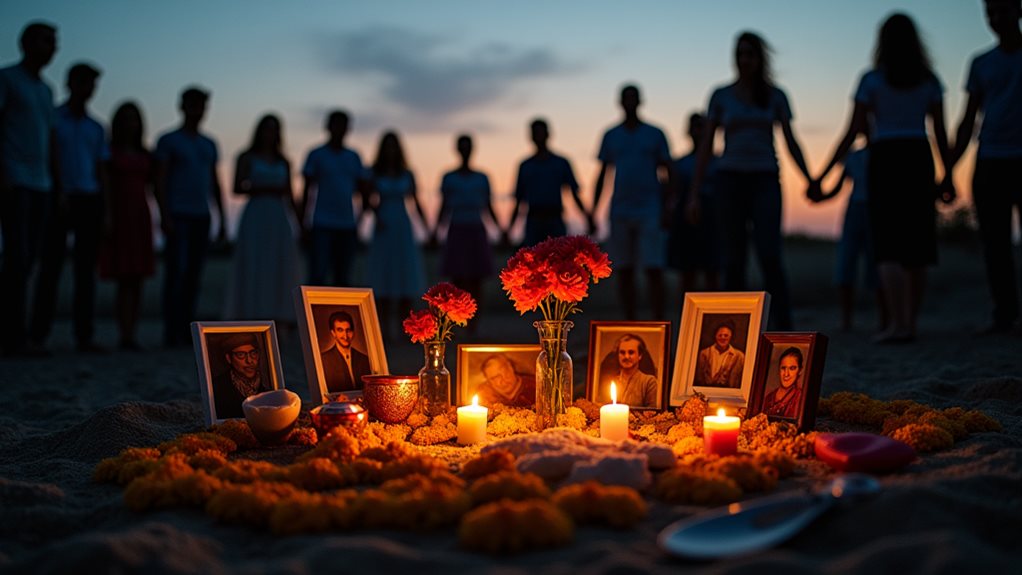
Death is not merely an end but a critical juncture in the perpetual cycle of existence, symbolizing profound transformation and renewal. It serves as a catalyst for introspection and reevaluation, encouraging a shift in priorities towards meaningful relationships and mindful living. Memorial traditions and celebrations of lives lived reinforce communal bonds and the intrinsic value of each individual's impact. By integrating personal loss, individuals often find new perspectives and appreciation for life's continuum, inviting further exploration into its transformative essence.
Key Takeaways
- Death marks not an end, but a transition in the continuous cycle of existence, promoting transformative experiences.
- It serves as a catalyst for personal growth and introspection, often leading to a reevaluation of life's priorities.
- Through rituals and celebrations, death helps communities bond and collectively honor the legacies of those who have passed.
- Experiencing loss can shift perspectives, fostering a more mindful and meaningful approach to daily life and relationships.
- Coping strategies like therapy, support groups, and personal reflection facilitate emotional healing and integration of loss into life's narrative.
The Nature of Death as a Cycle of Transformation
While often perceived as the final cessation of life, death is fundamentally an integral part of the life cycle, representing a profound change from one state of existence to another.
This transformation is not merely an end but a pivotal segment of continuous life cycles, essential for the renewal and evolution of the natural world.
Death catalyzes transformative experiences, facilitating new opportunities and growth. It embodies the necessary conclusion to former states, clearing space for emergent forms and beginnings.
In this way, death is not the antithesis of life but a requisite phase within an ever-unfolding cycle.
Reflective Insights Gained Through Experiencing Loss
Experiencing loss often precipitates profound reflection, compelling individuals to reconsider their life's trajectory and the nature of their relationships.
This introspective journey uncovers transformative experiences that alter one's perception of existence. Loss reflections can catalyze significant personal evolution, as individuals confront the temporal nature of life and the essence of what truly matters.
Key transformative insights include:
- Reevaluation of Priorities: Emphasizing relationships and personal fulfillment over material pursuits.
- Increased Empathy: Understanding and sharing the emotional states of others enhances connections.
- Renewed Purpose: Motivation to impact positively on others' lives, inspired by the legacies left behind.
The Ritual of Celebrating Lives Lived

The ritual of celebrating lives lived serves as a poignant convergence of collective memory and individual mourning. Memorial traditions embody the cultural fabric woven through generations, capturing the essence of honoring legacies left behind.
These ceremonies, whether solemn or celebratory, function as a communal catharsis, enabling participants to articulate grief and admiration in a shared space. Through the act of remembrance, societies not only pay tribute to the deceased but also reinforce communal bonds, ensuring the perpetuation of collective heritage.
Such rituals underscore the intrinsic value of life and the enduring impact of individuals on their community and beyond.
Embracing Life With a Renewed Perspective
Understanding the finality of death often compels individuals to reassess their priorities and view life through a lens of heightened appreciation and urgency.
This realization fosters a shift towards mindful living, where every moment is imbued with significance and every interaction is approached with intentionality.
The essence of this transformation can be encapsulated in three core elements:
- Prioritization of Meaningful Activities – Engaging in pursuits that resonate deeply on a personal level.
- Cultivation of Intentional Connections – Fostering relationships that are purposeful and enriching.
- Mindfulness in Daily Practices – Incorporating awareness and presence into everyday actions.
Strategies for Coping With Grief and Embracing Healing

While grief can be a profoundly personal and overwhelming experience, there are strategic approaches that facilitate coping and promote healing.
In the domain of grief management, it is essential to adopt a multifaceted strategy that incorporates both emotional and practical elements. This often includes therapy, structured support groups, and personal reflection practices.
As individuals traverse the path of emotional healing, they gradually reconstruct their internal narrative, integrating the loss into a revised understanding of self and world.
This transformative process allows for a re-engagement with life, marked by a deeper appreciation of relationships and existence itself.
Frequently Asked Questions
How Do Different Cultures Perceive the Concept of Death?
Different cultures perceive death through unique cultural rituals and symbolism, reflecting varied interpretations of life's end. These perceptions shape rituals that honor the deceased, signify beliefs about the afterlife, and influence mourning practices.
Can Pets Sense the Death of Their Owners?
Pets, with their seemingly supernatural animal intuition, often appear acutely aware of their owner's death, displaying profound grief expressions that reflect an innate understanding of loss, challenging our perceptions of non-human emotional depth and awareness.
What Are the Environmental Impacts of Burial Versus Cremation?
The environmental impacts of burial versus cremation vary considerably. Traditional burial often involves land use and chemical embalming, whereas cremation emits carbon and potentially toxic substances. Green burial presents a more eco-friendly alternative.
How Does Children's Understanding of Death Develop With Age?
Children's understanding of death evolves through various age stages, initially perceiving death as reversible and later grasping its permanence and universality, reflecting deeper conceptual awareness of life's finality and implications.
What Are the Legal Implications of a Person's Death?
The legal implications of a person's death include estate planning, managing inheritance laws, issuing death certificates, and engaging in the probate process. Tax implications and decisions regarding legal guardianship also arise, necessitating careful consideration.
Conclusion
Death, transcending its guise as an ultimate end, emerges as a profound catalyst for transformation. It compels introspection, celebrates existence, and renews perspectives, intertwining loss with rebirth. Mourning, while a passage of grief, also fosters healing through evolved coping strategies. Hence, death, in its enigmatic complexity, not only concludes a life but also perpetuates the cycle of human experience, urging the living to embrace the present, reflect deeply, and ultimately, celebrate the continuum of life.





